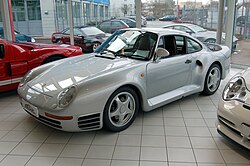In 1986, it held the title as the world's fastest street-legal production car. During its production run, it was hailed as the most technologically advanced road-going sports car ever built and the forerunner of all future super cars. It was one of the first high-performance vehicles to use an all-wheel drive system, providing the basis for Porsche's first all-wheel drive Carrera 4 model. In fact, it convinced Porsche executives of the system's viability so well that they chose to make all-wheel drive standard on all versions of the 911 Turbo starting with the 993 variant. In 2004, Sports Car International named the 959 number one on its list of Top Sports Cars of the 1980s.

Porsche 959
Development of the 959 (originally called the Gruppe B) started in 1981, shortly after the company's then-new Managing Director, Peter Schutz, took his office. Porsche's head engineer at the time, Helmuth Bott, approached Schutz with some ideas about the Porsche 911, or more aptly, a new one. Bott knew that the company needed a sports car that they could continue to rely on for years to come and that could be developed as time went on. Curious as to how much they could do with the rear-engined 911, Bott convinced Schutz that development tests should take place, and even proposed researching a new all wheel drive system. Schutz agreed, and gave the project the green light. Bott also knew through experience that a racing program usually helped to accelerate the development of new models. Seeing Group B rally racing as the perfect arena to test the new mule and its all wheel drive system, Bott again went to Schutz and got the go ahead to develop a car, based on his development mule, for competition in Group B.

Porsche 959 – the jeep-bashing
Porsche developed an already existing engine instead of creating a new one from scratch. The powerplant, a twin-turbocharged six-cylinder boxer engine with an air-cooled block and water-cooled heads, displaced 2.85 liters, about half a liter less than a contemporary 911 engine. It was coupled to a unique manual gearbox offering 5 forward speeds plus a "G" off-road gear, as well as reverse. The motor had originally been developed for the "Moby Dick" race car and then been redeveloped slightly for the short-lived Porsche Indy Car and several other projects before being "tweaked" a last time for use in the 961, the 959's racing counterpart. The water-cooled cylinder heads combined with the air-cooled block, 4-valve heads and sequential turbochargers allowed Porsche to extract 331 kW (444 hp) from the compact, efficient and rugged power unit. The use of sequential twin turbochargers rather than the more usual identical turbochargers for each of the two cylinder banks allowed for smooth seamless delivery of power across the engine RPM band, in contrast to the abrupt on-off power characteristic that distinguished Porsche's other turbocharged engines of the period. The engine was used, virtually unchanged, in the 959 road car as well.

Porsche 959

the Porsche 959 were AWD;

Porsche 959\x26#39;s were built

Porsche 959

Porsche 959
Development of the 959 (originally called the Gruppe B) started in 1981, shortly after the company's then-new Managing Director, Peter Schutz, took his office. Porsche's head engineer at the time, Helmuth Bott, approached Schutz with some ideas about the Porsche 911, or more aptly, a new one. Bott knew that the company needed a sports car that they could continue to rely on for years to come and that could be developed as time went on. Curious as to how much they could do with the rear-engined 911, Bott convinced Schutz that development tests should take place, and even proposed researching a new all wheel drive system. Schutz agreed, and gave the project the green light. Bott also knew through experience that a racing program usually helped to accelerate the development of new models. Seeing Group B rally racing as the perfect arena to test the new mule and its all wheel drive system, Bott again went to Schutz and got the go ahead to develop a car, based on his development mule, for competition in Group B.

Porsche 959 – the jeep-bashing
Porsche developed an already existing engine instead of creating a new one from scratch. The powerplant, a twin-turbocharged six-cylinder boxer engine with an air-cooled block and water-cooled heads, displaced 2.85 liters, about half a liter less than a contemporary 911 engine. It was coupled to a unique manual gearbox offering 5 forward speeds plus a "G" off-road gear, as well as reverse. The motor had originally been developed for the "Moby Dick" race car and then been redeveloped slightly for the short-lived Porsche Indy Car and several other projects before being "tweaked" a last time for use in the 961, the 959's racing counterpart. The water-cooled cylinder heads combined with the air-cooled block, 4-valve heads and sequential turbochargers allowed Porsche to extract 331 kW (444 hp) from the compact, efficient and rugged power unit. The use of sequential twin turbochargers rather than the more usual identical turbochargers for each of the two cylinder banks allowed for smooth seamless delivery of power across the engine RPM band, in contrast to the abrupt on-off power characteristic that distinguished Porsche's other turbocharged engines of the period. The engine was used, virtually unchanged, in the 959 road car as well.

Porsche 959

the Porsche 959 were AWD;

Porsche 959\x26#39;s were built

Porsche 959
No comments:
Post a Comment